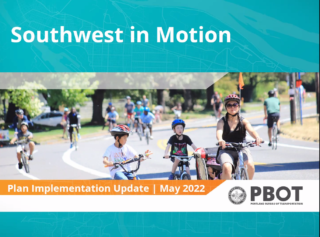
Portland Bureau of Transportation (PBOT) Transportation Planner Corrine McQueen presented an update on the Southwest in Motion (SWIM) plan to the board of SWTrails PDX on Thursday, May 26th.
The meeting came after several SWIM stakeholders had, for nearly a year, inquired about the lack of updates to the SWIM project web page, and a yet-to-be-completed two-year progress report which was expected last fall.
McQueen shared slides which showed the status of various projects as active or completed, but pointed out that this was a “draft” report, and that she was soliciting corrections from the group before loading the data to the project website. She noted that although the SWIM plan had been completed in the summer of 2019, “every part of the project delivery process has been impacted by the pandemic, from funding resources to shifting priorities of the city in response to the pandemic.”
The SWIM document (PDF) stated that the plan was a “short-term prioritization, refinement, and implementation strategy for planned active transportation investments in Southwest Portland.” And that it “identifies a realistic short-term action plan that provides basic walking and bicycling connectivity where they are needed most.”
“Short-term” was generally understood to be under five years, although in the written plan a “possible future” graphic shows Tier 1 projects implemented by the end of 2025. SWIM stakeholder and long-time bicycle activist Keith Liden emailed that he “wanted them to pin it down to at least a range, similar to the Transportation System Plan (TSP) where I believe 1-10 years would be the equivalent of short-term. With a lack of money and commitment, the staff preferred to keep it totally vague.”
Advertisement

Comparing the original “Crossing Enhancement” project list of 53 projects to the updated crossing project slide at right shows that 19 projects have been completed, and that five are active, for a total of 24 projects—or just short of half the original crossings project list.
Of the list of 77 larger-scaled projects, 21 are active or have been completed–or a little more than a quarter of the projects.
To be fair, the SWIM project lists were in some part a catalogue of needs rather than a funded to-do list. And although each project description came with a potential funding source, it was made clear that funding had not been secured.
With a total of 130 projects, give or take a few, it has been difficult for southwest residents to follow, provide input about, or anticipate the implementation of the SWIM plan. This has been exacerbated by the fact that bins of projects have been given to various project managers, each of whom may have a different style of interacting with the public, as well as a different page on the PBOT website.
McQueen acknowledged that “it’s difficult to wrangle bits of information, status of things. PBOT has many employees, and it’s a little tricky to get all that information and bring it into one place,” and she mentioned that their team had discussed having an interactive ArcGIS project map, although they “haven’t got that launched.”
Advertisement
SWIM stakeholder and SWTrails founder Don Baack was particularly concerned about the lack of interaction between the PBOT team and the community:
When we completed the SWIM plan, there was a promise to work with us on the crosswalks, and that never happened… When we asked all the neighbors which were the most important crosswalk projects, something like only about 10 or 15% of those were on the list that PBOT thought were important. So there is a big disconnect there, and we need to have a discussion, and not just PBOT decide which ones are important.
All of the current projects are funded through Fixing Our Streets, which has $500,000 allocated for SWIM projects. This prompted board member Glenn Bridger to comment that “you’re talking about $500,000 in funding to take care of probably $20 million, $30 million in needs. You need to be getting SWIM funded to a level that’s consistent with what the city, as whole, has learned to expect. That means our arterials are safe for people to walk on.”
Setting aside the spreadsheets, and the community problems with inadequate transparency, SWIM projects have nonetheless had a strong impact in areas where they have been completed: the bicycle and pedestrian crossings at the Patton/Montgomery and Patton/Talbot/Greenway intersections; the enhanced crossings at Dosch/30th and Beaverton-Hillsdale Highway; the protected bike and pedestrian lanes on Beaverton-Hillsdale Highway; the road diet on Capitol Highway between Huber and Kerr, and others. Together with the recently completed Red Electric Bridge and the ongoing Capitol Highway project, these areas feel much safer than they did five years ago.
Despite some robust criticism, the meeting was cordial and McQueen ended on a positive note, thanking the group “for the strong emphasis on what is needed … and celebrating some of the wins.”
But the group still wants to talk with SWIM Project Manager Nick Falbo, who had backed out of Thursday’s meeting with short notice. Board President Doug Rogers ended the discussion with, “we were hoping to have Nick Falbo come … maybe next month we will be able to get him over here.”


